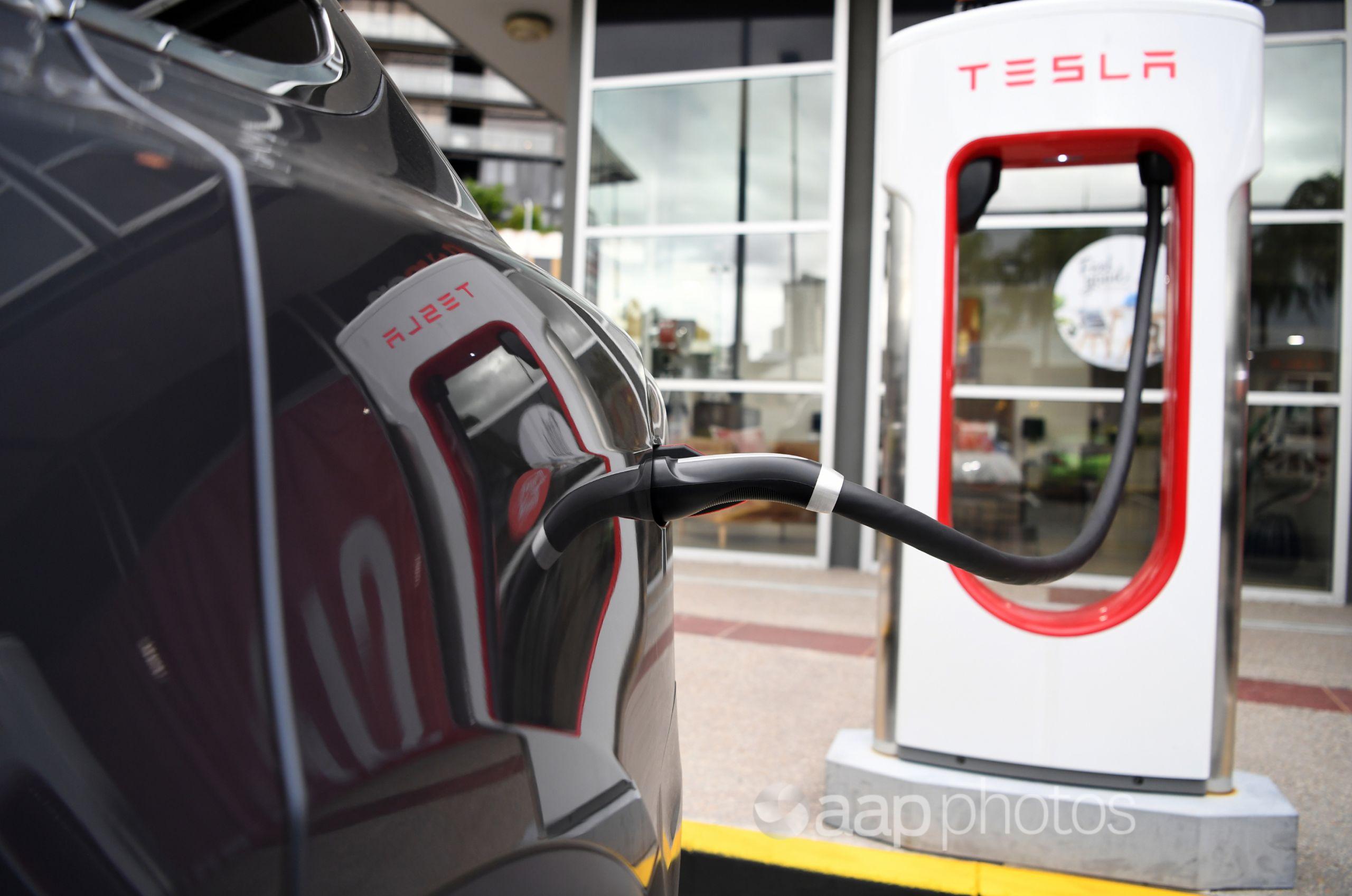AAP FactCheck Investigation: Does manufacturing an electric vehicle produce twice the greenhouse emissions of a fossil-fuel powered car?
The Statement
“The construction of an electric car takes double the amount of carbon emissions than an internal combustion engine car or traditional car does.”
Matt Canavan, Queensland Senator, The Nationals, December 10, 2020.
The Analysis
Queensland Senator Matt Canavan has questioned the environmental benefits of electric cars, claiming that it takes twice the greenhouse gas emissions to produce the vehicles compared to those with internal combustion engines.
The Australian National Party senator, an advocate for building more fossil fuel-fired power stations, made the comments after Infrastructure Victoria released a draft 30-year strategy for the state to reach net zero emissions by 2050. The first of its 85 recommendations was to accelerate the uptake of zero-emission vehicles (page 16).
During an interview on Sky News, a clip of which was posted to Facebook on December 10, Mr Canavan compared the strategy to the Soviet Union’s five-year plans under leader Joseph Stalin and questioned whether electric vehicles (EVs) would help reduce greenhouse emissions. (Video mark 1min 23 sec).
“Presumably they’re saying they want everybody driving electric cars because they think it’s going to save the planet, but the construction of an electric car takes double – double – the amount of carbon emissions than an internal combustion engine car, or a traditional car does,” Mr Canavan said.
“It can make up those carbon emissions over the life of the car depending on where you get the electricity from, but if you’re in Victoria you’ll get about 70 per cent of your electricity from coal right now.”
AAP FactCheck examined Mr Canavan’s statement that EVs produce double the greenhouse emissions of an internal combustion engine vehicle (ICEV) during manufacturing.
When contacted to provide evidence in support of the claim, Mr Canavan’s office emailed a list of sources.They included a 2019 Forbes article discussing whether EVs were better for the environment than ICEVs.
The article said EVs were often criticised due to the pollution caused by manufacturing EV batteries, but it noted one report from the International Council on Clean Transportation (ICCT) found these emissions were highly dependent on where the batteries were produced.
It said another study, which compared emissions from EVs and ICEVs manufactured in China, found EVs produced up to 60 per cent more CO2 during production than ICEVs, but these emissions could be reduced by up to 66 per cent “if they adopted American or European manufacturing techniques”.
“As such, the pollution created through the extraction process and production of batteries remains on par or slightly higher than the manufacturing process of petrol or diesel-based engines,” the article said.
It said EVs would also become more efficient in future and produced considerably lower emissions over their lifetime compared with an ICEV, regardless of the electricity mix used to power them.
The second source Mr Canavan’s office supplied was the ICCT report cited in the Forbes article. It looked at the manufacturing emissions of EV batteries and found estimates varied significantly, from 56 kilograms of carbon dioxide-equivalent per kilowatt-hour of battery capacity (kg CO2e/kWh) to 494kg CO2e/kWh (page 2).
“The wide range of values found in these studies indicates the degree of uncertainty in assessing life-cycle emissions and the variety of methods and materials used in manufacturing batteries,” it said.
It noted that the largest share of manufacturing emissions came from the electricity used to produce the battery, adding that using cleaner power sources in factories would significantly reduce the carbon footprint.
The report also compared emissions for a 2017 Nissan Leaf with those from an “average European car” from 2015 and a 2017 Peugeot 208 (page 4). It said manufacturing emissions for the EV were roughly double those for the ICEV vehicles (Figure 1, page 5).
But over its life cycle, the Leaf’s emissions were about 50 per cent lower after 150,000km “even when assuming relatively high battery manufacturing emissions”.
The modelling assumed that manufacturing the Leaf’s battery produced 175kg CO2e/kWh, a figure that other research suggests may be outdated.
A 2019 Swedish review assumed EV battery manufacturing emissions of between 61 and 106kg CO2e/kWh after factoring in the use of renewable energy in the production process.
The third source Mr Canavan’s office provided was a 2020 article by Transport & Environment, an organisation which describes itself as “Europe’s leading clean transport campaign group”.
The article, titled How Clean Are Electric Cars?, compared the emissions from EVs in countries with different levels of renewable electricity in their grids. It showed the emissions from manufacturing EVs was significantly higher than for ICEVs but not quite double.
The report showed EVs produced significantly lower emissions over their life cycles in all modelled countries. Even in Poland, where only around 13 per cent of electricity came from renewable sources in 2018, the EV had 29 per cent lower emissions than an average diesel or petrol powered vehicle.
Mr Canavan’s office also cited a fact check which examined a German study that claimed electric vehicles produced more emissions than diesel vehicles over their life cycles. The fact check found the study’s findings were mostly false. The German study has also been criticised by multiple experts (including here, here, here)
AAP FactCheck‘s research found estimates for EV manufacturing emissions varied widely. The results often depend on the capacity of the battery used, whether the electricity used during manufacturing was from renewable sources and other underlying assumptions.
A 2015 report by the US Union of Concerned Scientists estimated the emissions of manufacturing a mid-sized EV based on a Nissan Leaf and a “full sized” vehicle based on a Tesla Model 3, and compared these with similar ICEVs.
It found on average the Leaf’s manufacturing emissions were 15 per cent higher than an ICEV, while the Tesla’s emissions were 68 per cent higher, which was mostly due to its larger battery (Figure 7, page 21). However, over the lifetime of the vehicle the Leaf’s emissions were about 51 per cent lower, while the Tesla’s emissions were 53 per cent lower than a comparable ICEV.
It said EV manufacturing emissions could be reduced by around 30 per cent if a car was produced using 80 per cent renewable energy rather than the average emissions from the US energy grid (page 23).
A 2016 study looked at the comparable manufacturing emissions for a Nissan Leaf, Chevrolet Volt, Toyota Prius and a Mazda 3. It found the Nissan Leaf produced nearly double the emissions during production against the Mazda and the Toyota (pages 5-6, table 2 and 3).
A 2020 study from researchers in The Netherlands compared manufacturing emissions from three EVs and three ICEV vehicles (page 5). It found manufacturing emissions of a Volkswagen eGolf were 25 per cent higher than for a Toyota Prius; emissions for a Tesla Model 3 were 59 per cent higher than for a Mercedes C-class diesel; and emissions from a Porsche Taycan S EV were 60 per cent higher than a Bugatti Veyron.
A 2017 study compared EV and ICEV manufacturing emissions in China and found the EV emissions were about 50 per cent higher. Another study in China compared emissions from an EV and ICEV Ford Focus and estimated emissions were 39 per cent higher for the EV.
A report by Volkswagen, released in 2019, compared the life-cycle emissions of the Volkswagen Golf powered by an electric motor and a diesel internal combustion engine. It found emissions from manufacturing the EV were nearly double that of the diesel vehicle (page 1). New technology in its new EV, the ID, reduced emissions from producing the battery by more than 25 per cent.
A company webpage expanded on the research to show the EV Golf had lower lifetime emissions than the diesel version after 125,000km, based on the average EU electricity mix. However, in Germany, where 42.1 per cent of electricity generation was from renewables in 2019 (page 45), the EV had higher life-cycle emissions based on a life span of 200,000km.
A 2019 report by Tesla analysed the environmental impact of its business and claimed manufacturing emissions were “nearly comparable” to an average ICEV (page 11).
University of Queensland research fellow and EV researcher Jake Whitehead said the emissions from producing an electric car were generally higher than for an ICEV, but this depended on the energy used to power the manufacturing facilities.
Dr Whitehead estimated EVs currently have 50 to 100 per cent higher emissions during production, but some manufacturers claimed to be approaching emissions parity with ICEVs.
He said Tesla, whose Model 3 was the highest selling EV in Australia, had relatively low manufacturing emissions and its Nevada ‘Gigafactory’ was designed to have net zero emissions.
He said the Volkswagen report was misleading as the electric Golf was a retrofitted ICEV vehicle and so would not be as efficient as a purpose-built EV, while the fuel-efficiency assumptions for the diesel Golf also appeared to be unrealistically high.
Dr Whitehead referred to an Australian study, which he peer-reviewed, that estimated EV manufacturing emissions were 20 per cent higher than an ICEV (page 12).
A report published by the European Commission (EC) in July also provided a comprehensive analysis of life-cycle emissions of EVs and found manufacturing emissions were higher but not double (Figure ES5, page 9).
It also found that the average lifetime emissions for a medium-sized EV across the EU were only 45 per cent of those from a petrol-powered equivalent.
“There is clear evidence that, in almost all cases EVs have lower (lifetime) emissions than ICEVs,” Dr Whitehall said.
Mr Canavan is correct that 70 per cent of Victoria’s electricity comes from coal-fired power stations, with 20 per cent from renewable sources as of 2019.
However, Dr Whitehall said, based on the EC report, an average EV in Victoria would produce about 20 per cent less greenhouse emissions on a life-cycle basis.
The Verdict
AAP FactCheck found the claim that electric vehicles produce twice the greenhouse emissions of an internal combustion engine vehicle during manufacturing to be misleading.
Based on the available research, most electric vehicles produce significantly more greenhouse emissions during manufacturing than their conventional equivalents. While some studies found emissions were double, others indicated the emission premium was only 20 per cent.
Most research shows EVs emit significantly less emissions over their lifetimes than ICEVs, even when they are charged from electricity grids with a high proportion of fossil-fuel sources.
Misleading – The claim is accurate in parts but information has also been presented incorrectly, out of context or omitted.
* Editor’s note: AAP FactCheck has expanded its ability to fact-check environmental issues with the support of the Australian Conservation Foundation. AAP FactCheck retains full editorial independence in this project and continues to apply the rigorous standards required for accredited members of the International Fact-Checking Network.
All information, text and images included on the AAP Websites is for personal use only and may not be re-written, copied, re-sold or re-distributed, framed, linked, shared onto social media or otherwise used whether for compensation of any kind or not, unless you have the prior written permission of AAP. For more information, please refer to our standard terms and conditions.


















